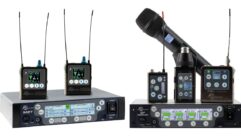

Wireless In-ear Monitoring Systems
Oct 12, 2009 12:00 PM,
By Bennett Liles
Clarity and comfort have brought stage monitoring under control.
Sidebar
Custom Earphones: The Ultimate Solution
AKG SPR 4 receiver
In-ear monitoring (IEM) is at the apex of a series of tech advances that have led up to the ability of stage performers having their own customized monitoring environment in a live music situation. In the ’60s, stage monitoring was a radical, new-age concept at a time when even the Beatles were miking drums in live concerts with a single omnidirectional EV635 overhead. It didn’t matter because no one could hear them playing above the usual adolescent shrieking. As their music and that of other performers became more sophisticated, the live stage systems used by such performers had to evolve to deliver to paying concert crowds the same sound quality and definition that had been heard on the groups’ records.
Related Links

Audio Review: Sensaphonics 3D Active Ambient
Personal monitors are great, but unfortunately, they isolate the performer from the audience and other band members. This is due to the fact that—when properly implemented—earpieces prevent the majority of ambient sound from reaching the ear…

Technology Showcase: Wireless In-ear Monitoring Systems
In 1990, only the top names in musical entertainment could be seen using in-ear monitoring systems…

Technology Showcase: Assistive-listening Systems
As sound systems have grown increasingly sophisticated in their capabilities and control options, installers and operators have also reached a new level of understanding of the importance of room acoustics and the methods of electronic distribution…
By the ’90s, enough performers had put together do-it-yourself IEM systems that manufacturers recognized the trend and produced wireless models with better control, while the firms that had been making custom interruptible feedback (IFB) earpieces for TV anchors and reporters found a new market in stage musicians and vocalists. The same technology that was pushing the envelope on wireless microphone systems with frequency agility, improved receiver selectivity, and more recently, automatic frequency assignment, was used to deliver better performance for rapidly evolving IEM systems. Now these systems are everywhere providing much better monitoring clarity, eliminating feedback, and drastically reducing the hernia factor for stagehands and roadies.
Most of these systems include in their feature set a multimode operation with a choice of one mix in both ears or separate, customized monitor feeds in each ear—an ambient microphone feed that some performers prefer in order to avoid feeling isolated from the onstage environment—along with connection loop-through, switchable RF output power, pilot tone muting, limiting, and infrared transmitter/receiver sync brought over from the modern wireless microphone advances. Of course, battery power is critical, and these systems also employ the same power-monitoring features in the body-pack receivers that are used in wireless microphone transmitters.
The IVM 4 set from AKG is an in-ear monitoring system that includes the SS 4 stereo transmitter and the SPR 4 body-pack receiver. The SS 4 allows up to 14 channels within a 30Mhz UHF band. Any of the 1,200 frequencies can be manually selected using the unit’s front-panel controls, providing compatibility with AKG’s WMS 400 or WMS 4000 wireless microphone systems in frequency selection and in the use of an adjustable RF output level. The SS 4 also features an audio input loop-out to feed multiple units with the unprocessed input audio signal, and the input level to each unit is individually adjustable ±20dB. Using the optional Hub 4000 Q, the SS 4 can be integrated into a Harman Professional HiQnet system, controlled and remotely monitored with a PC through the System Architect software with control features that include RF monitor, device manager, environment scan, and auto setup. The transmitter operates on frequency bands from 500MHz to 865MHz with an audio frequency response from 35Hz to 20kHz. The SPR 4 body-pack receiver has auto setup and environment scan in addition to RF-signal-strength indicator and the Smart Battery Management System. The BP 4000 battery pack charged by the CU 4000 charger can keep the unit up and running for up to 7 hours.

Audio-Technica M2 system
The M2 wireless in-ear monitoring system from Audio-Technica consists of the M2T UHF stereo transmitter and the M2R stereo receiver. The M2T, with its 100 UHF channels, has an interesting front-panel display with a dual peak meter and left/right signal indicators along with three operation modes: personal mix, stereo, and mono. The unit features a switched limiter, pilot tone muting to avoid RF blasts when the transmitter is turned off, and an XLR loop-through to feed up to 10 additional transmitters. It also has an auxiliary input for connection of ambient mics, click track, or other sources. The audio frequency response of the M2T is 60Hz to 13kHz ±3dB with a maximum dynamic range of 90dB. Depending on local availability, the system can be capable of operating on any of four 100-channel bands between 575MHz and 865MHz. The M2R receiver uses a 3.5mm TRS headphone connection, and it can operate up to 8 hours on two AA alkaline batteries. The included EP3 headphones have proprietary dynamic drivers, three sizes of rubber ear tips, and an ear-conforming foam tip.
Wireless In-ear Monitoring Systems
Oct 12, 2009 12:00 PM,
By Bennett Liles
Clarity and comfort have brought stage monitoring under control.

Beyerdynamic IMS 900 transmitter
Beyerdynamic designed the IMS 900 in-ear monitoring system for simplicity in setup and programming with the system available in the United States in the band of 620MHz to 644MHz with 16 preprogrammed channels, any eight of which can be used simultaneously. On the SE 900 transmitter, the frequency and channel are displayed on the front LCD. The system also features pilot tone muting to avoid blasts of extraneous audio in the earphones when the transmitter is turned off, adjustable input gain control, a mono/stereo switch, and a headphone output with volume control. The TE 900 receiver uses diversity reception for dropout-free operation. There is also adjustable squelch (2µV-100µV) and a switchable limiter. The front display shows channel setting, and the unit has LED indicators for battery level and RF signal. For adjustment of the two monitor signals, there is also a balance control that works as a pan pot to shift the left and right earphone levels. The operating time on two AA batteries is approximately 10 hours. The IMS 900 system may be used with the DT 60 Pro earphones, which come with three sizes of silicone ear pads.

Carvin EM900 System
Delivering 30Hz to 15kHz audio frequency response and an A-weighted signal-to-noise ratio of 80dB, the CarvinEM900 system offers 960 channels and has a built-in limiter and twin combination 1/4in.-and-XLR audio output connectors on the aluminum case. The audio input level is switchable between 0dB and -10dB with a channel separation figure of 35dB and an audio loop-through for feeding multiple transmitters on the same audio signal. The transmitter also has an earphone output with volume control. The transmitter and receiver have LCD panels displaying frequency and channel, and these are set with adjacent pushbuttons. The EM901 receiver’s LCD shows battery condition, and the unit offers a pan control for adjustment of the two independent audio signals in stereo or mono. The EM902 ear buds are available as an option with highly flexible braided cable, and transparent driver enclosures make them virtually invisible on the user.

Galaxy Audio AS-1500 Any Spot system
The AS-1500 Any Spot wireless personal monitor system from Galaxy Audio transmits a 10mW UHF signal in the 655MHz-to-679MHz range in either stereo or mono mode for a normal operating range of 300ft. with 120 selectable channels. The audio frequency response is 60Hz to 16kHz ±3dB with a signal-to-noise ratio above 80dB. The AS-1500T features twin 1/4in.-and-XLR audio output connectors with an adjustable input level and a front-panel LCD that shows left and right audio levels, group and channel numbers, mode select, and other information. These parameters are adjusted with adjacent up, down, and set buttons. The unit also has a 1/4in. local headphone output with volume control. The AS-1500R receiver operates in mixed mono mode with a mix control and features a level control, EQ boost, limiter switch, and LCD that shows group/channel, RF and audio levels, limiter select, mode information, and a three-bar battery-level indicator. Operation on two AA batteries is about 6 hours.
Wireless In-ear Monitoring Systems
Oct 12, 2009 12:00 PM,
By Bennett Liles
Clarity and comfort have brought stage monitoring under control.

Hear Technologies Freedom Back receiver

Hear Technologies Freedom Back transmitter
Hear Technologies introduced the Freedom Back wireless in-ear monitor system to complement the Hear Back personal monitor mixer and Mix Back matrix monitor mixer. The system is available on either the UA or UB bands. The UA band ranges from 584MHz to 608MHz, and the UB band ranges from 655MHz to 679MHz. There are up to 120 digitally selectable channels in each of these bands depending on availability in the local frequency spectrum. Up to 10 transmitters may be used simultaneously in the same location, and each may run in mono or stereo mode with separate input level controls. Input signals enter on combination 1/4in.-and-XLR connectors, and the transmitter has a built-in automatic limiter, a switchable 12dB attenuator pad, a headphone port with volume control, and a back-lit front-panel LCD showing frequency, audio level, group, and channel with three menu navigation buttons. The receiver has its own LCD showing group/frequency, mode, RF and AF levels, and battery life. The unit works for 4 hours to 5 hours on two AA batteries. There is also an RF-signal-presence LED and three menu navigation buttons for setup and frequency selection.

Mipro MI-808 receiver

Mipro MI-808 transmitter
For the needs of a very simple and quick in-ear monitoring solution, Mipro offers the MI-808 system with the MI-808T transmitter featuring 16 selectable preprogrammed frequencies, pilot tone muting, dynamic expander circuitry delivering a signal-to-noise ratio of more than 90dB, a built-in limiter, and a front-panel headphone monitoring jack with volume control. Output power is selectable between 10mW and 100mW, and the audio frequency response extends from 80Hz to 15kHz ±3dB. Input signals enter on combo 1/4in.-and-XLR connectors, and the unit comes with a pair of rack ears. The front-panel LCD shows channel and frequency, and these are adjusted with adjacent menu navigation buttons. The MI-808R receiver uses diversity reception with dynamic expander circuits and stereo/mono operation. The unit includes power and RF-signal indicators, and the LCD shows the channel number. All of this is housed in a magnesium alloy case, and it runs on AA batteries.
Wireless In-ear Monitoring Systems
Oct 12, 2009 12:00 PM,
By Bennett Liles
Clarity and comfort have brought stage monitoring under control.
The PEM-500 from Nady offers 16 PLL synthesized, user-selectable UHF channels and either stereo- (MPX system) or mono-mode transmission. Depending on the country and frequency band, up to eight systems can be used simultaneously. The 1/2RU, all-metal PEM-500T transmitter can be mounted in two side-by-side units or singly with the appropriate rack-mount accessories, and the system provides proprietary companding circuitry for wide dynamic range. On the front panel is an input level control, a headphone jack with volume knob, an LED channel display with selector button, and a stereo 10-segment audio-level meter. The rear panel includes a stereo/mono select switch, BNC antenna connector, 1/4in. TRS balanced mic input, and twin XLR line inputs. The PEM-R receiver has a built-in limiter, power switch, output level control, stereo/mono switch, and a two-color, three-way on/signal/low-battery indicator. The unit can operate for up to 6 hours on a 9V alkaline battery. Each receiver comes with a pair of in-ear headphones with three sizes of rubber mounts.

Sennheiser SR 2050 transmitter
One of the top IEM systems from Sennheiser is the 2000 series. The series includes the SR 2050 IEM transmitter, which is actually a rackmount unit housing two transmitters in a 1RU space. The SR 2050 IEM can operate on stereo or mono mode with HDX noise reduction system on channels from 516MHz to 698MHz. The front panel includes an LCD for each transmitter that shows frequency, AF level for each channel, and EQ setting. There is also a front-panel headphone jack with volume control for each transmitter, a jog dial, and a standby button along with an infrared sync interface with sync button that transmits a selected frequency to the receiver, automatically setting it to the same channel as the transmitter. The rear panel includes dual audio inputs with combo 1/4in.-and-XLR connectors, loop-through jacks, cable grip, and an RJ-45 LAN connector with network activity indicator. When networked with other transmitters, the SR 2050 IEM can be centrally controlled from a PC running Sennheiser’s Wireless Systems Manager software. The EK 2000 IEM receiver uses the earphone cable as a second antenna to reduce drop outs. Along with AF and RF levels and frequency, the LCD shows battery condition. For power, the unit can use either two AA batteries or the BA 2015 rechargeable battery pack.

Shure PSM 700 system
The ShurePSM 700 in-ear monitor system consists of the P7T transmitter, the P7R receiver, the PA715 antenna, and the SCL3 earphones. The transmitter operates in stereo or mix mode with 32 user-selectable frequencies and MPX stereo audio transmission. The transmitter also features a switchable input level between +4dBu and -10dBv along with a front-panel headphone monitoring jack and volume control. Dual inputs use 1/4in.-and-XLR combo connectors with loop-through outputs, and the internal power is also switchable between 120V and 230V. The transmission uses tone-key squelch to avoid reception of stray signals when the transmitter is powered down. The P7R receiver has a switchable high-frequency boost and volume/balance dials. The operating range is about 300ft. with an audio frequency response of 50Hz to 15kHz (+0, -3dB), depending on earphones used.
Custom Earphones: The Ultimate Solution
For many musicians, it has been enough of a challenge to get used to the isolation of an in-ear monitor but having ear buds come loose and even pop out onstage is simply unacceptable for professional performers. The answer to this problem evolved right along with the IEM systems themselves and today it is quite common for professionals and part-time pros to have custom-made ear monitors. At anywhere from $100 to $200 or more, they are considerable higher in cost than standard models, but the fitting process is pretty simple and quick. Here are some links to more information and videos showing how it’s done.
What is the process for having custom earplugs made?










